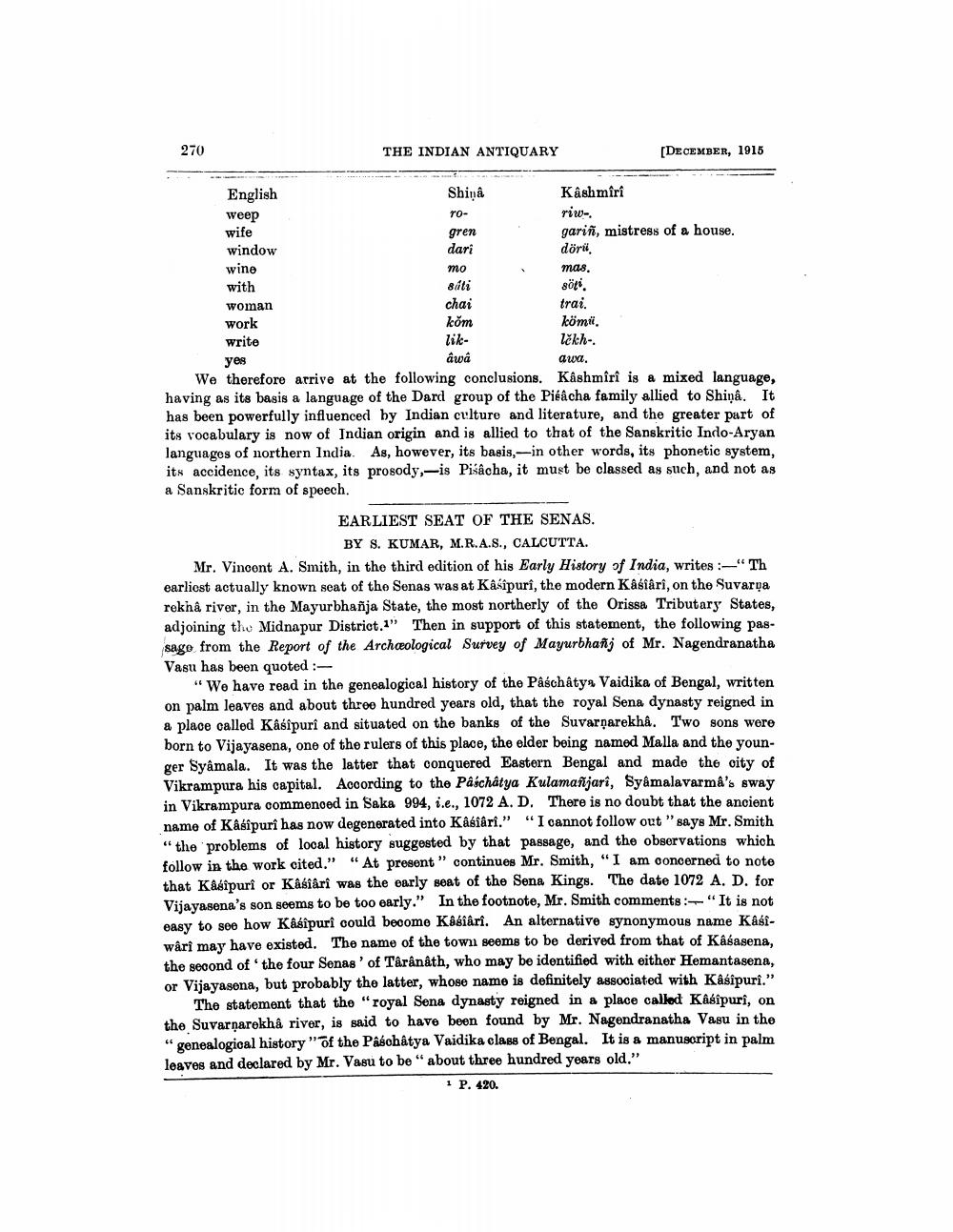________________
270
THE INDIAN ANTIQUARY
[DECEMBER, 1915
English
Shiņa
Kashmiri weep
TO
riwwife
gren
gariñ, mistress of a house. window
dari
dörii wino
mo
mas. with
siti
söti. woman
chai
trai. work
kom
kömii. write
lčkhyes
Qua
awa. We therefore arrive at the following conclusions. Kashmiri is a mixed language, having as its basis a language of the Dard group of the Pikacha family allied to Shiņa. It has been powerfully influenced by Indian culture and literature, and the greater part of its vocabulary is now of Indian origin and is allied to that of the Sanskritic Indo-Aryan languages of northern India As, however, its basis,-in other words, its phonetic system, its accidence, its syntax, its prosody,-is Pisacha, it must be classed as such, and not as a Sanskritic form of speech.
EARLIEST SEAT OF THE SENAS.
BY S. KUMAR, M.R.A.S., CALCUTTA. Mr. Vincent A. Smith, in the third edition of his Early History of India, writes :-"Th earliest actually known seat of the Senas was at Käsipurî, the modern Kasiâri, on the Suvarya rekha river, in the Mayurbhañja State, the most northerly of the Orissa Tributary States, adjoining the Midnapur District.1" Then in support of this statement, the following passage from the Report of the Archeological Survey of Mayurbhanj of Mr. Nagendranatha Vasu has been quoted :
"We have read in the genealogical history of the Paschâtys Vaidika of Bengal, written on palm leaves and about three hundred years old, that the royal Sena dynasty reigned in a place called Käsipuri and situated on the banks of the Suvarnarekha. Two sons were born to Vijayasena, one of the rulers of this place, the elder being named Malla and the younger Syamala. It was the latter that conquered Eastern Bengal and made the city of Vikrampura his capital. According to the Paschâtya Kulamañjari, Syâmalavarmâ's sway in Vikrampura commenoed in Saka 994, i.e., 1072 A. D. There is no doubt that the ancient name of Käsipuri has now degenerated into Käsiâri." "I cannot follow out "says Mr. Smith "the problems of local history suggested by that passage, and the observations which follow in the work cited." "At present " continues Mr. Smith, "I am concerned to note that Kasipuri or Kablari was the early seat of the Sena Kings. The date 1072 A. D. for Vijayasena's son seems to be too early." In the footnote, Mr. Smith comments - "It is not easy to see how Käsipuri could become Kassari. An alternative synonymous name Kasiwâri may have existed. The name of the towul seems to be derived from that of Kasasena, the second of the four Senas' of Târânath, who may be identified with either Hemantasena, or Vijayasona, but probably the latter, whose name is definitely associated with Kasipuri."
The statement that the "royal Sena dynasty reigned in a place called Käsipuri, on the Suvarnarekha river, is said to have been found by Mr. Nagendranatha Vasu in the "genealogical history "of the Pasohâtya Vaidika class of Bengal. It is a manuscript in palm leaves and declared by Mr. Vasu to be "about three hundred years old."
1 P. 420.




